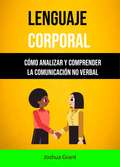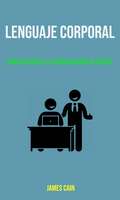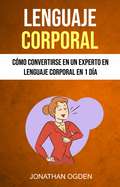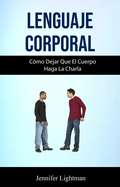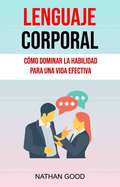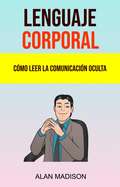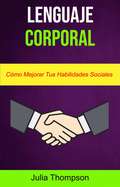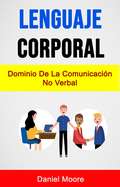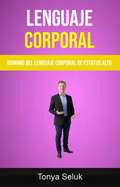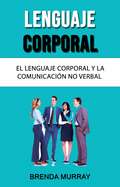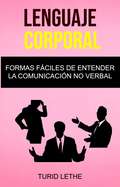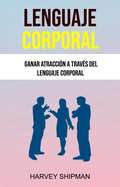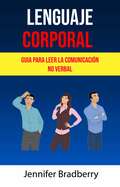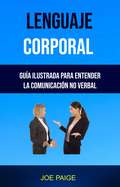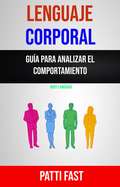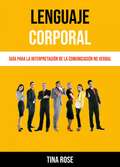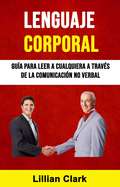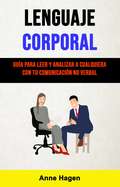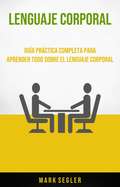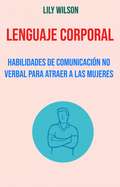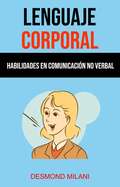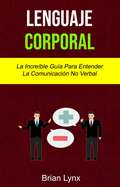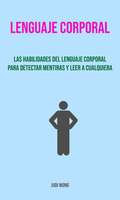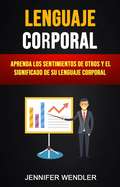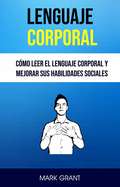- Table View
- List View
Lenguaje Corporal: Cómo Analizar Y Comprender La Comunicación No Verbal
by Joshua GrantContrariamente a la creencia común de que aprender a leer el lenguaje corporal no es difícil. Body Language 101 te lleva de la mano y te muestra cómo cualquier persona puede leer las señales reveladoras del lenguaje corporal y con ello saber lo que la otra persona está pensando REALMENTE, contrario a lo que realmente podría estar diciendo. Las habilidades que aprenderás en este libro mejorarán aenormemente tus interacciones y relaciones sociales, ya sean de negocios o de placer. Este libro te ayudará a comprender y utilizar diferentes tipos de comunicación no verbal. Al usar los principios y las instrucciones de este libro, aprenderás los mejores tipos de lenguaje corporal para emplearlos en diferentes tipos de situaciones sociales. ¡Descarga este gran libro hoy!
Lenguaje Corporal: Cómo Aprender La Comunicación No Verbal
by James CainAlgunas investigaciones han demostrado que el lenguaje corporal transmite la mayoría de la información en las interacciones interpersonales. Regula la interacción y establece relaciones. Sin embargo, el lenguaje corporal también es ambiguo. Como tal, es importante que la persona interprete correctamente el lenguaje corporal para evitar malentendidos. Comprender cómo leer y transmitir señales no verbales es una parte importante de la comunicación. Lo hacemos automáticamente sin siquiera saber que lo hacemos, entenderlo es la palabra clave. Aún así, si quieres dominar el lenguaje corporal para manipular a otros, es probable que no tengas el menor éxito y que al final desconfíen de ti. No esperes más, descubre TU LLAVE hacia una vida nueva y mejor.
Lenguaje Corporal: Cómo Convertirse En Un Experto En Lenguaje Corporal En 1 Día
by Jonathan OgdenEn Lenguaje Corporal encontrarás las estrategias sobre cómo usar la comunicación no verbal en varios tipos de interacciones sociales para alcanzar diferentes objetivos sociales. El lenguaje corporal, también conocido como la comunicación no verbal, en cómo nos expresamos a través de los gestos, expresiones, posturas, tono, contacto visual, ritmo de habla y mucho más. Si alguna vez escuchaste la expresión “las acciones hablan más fuerte que las palabras” habrás oído una verdad universal. Las acciones que toma nuestro cuerpo sin siquiera pensarlo son de hecho, muy comunicativas; y es precisamente por esto que necesitamos comprender que son y cómo usarlas para nuestro beneficio. Obtén este libro hoy.
Lenguaje Corporal: Cómo Dejar Que El Cuerpo Haga La Charla
by Jennifer LightmanMejorar tus habilidades interpersonales es uno de los mejores pasos que puedes tomar para ayudar a aumentar tu autoconfianza y su felicidad. Al comprender las señales no verbales que otras personas nos envían, entenderemos mejor los mensajes y la situación, lo que nos permitirá reaccionar y abordarlos de la manera más apropiada. Si más personas son capaces de percibir y comprender mejor cómo se sienten los demás con respecto a ellos y el significado real de lo que intentan transmitir, pueden ajustar su comportamiento y sus reacciones en consecuencia. Por lo tanto, aumentan sus posibilidades de hacer más conexiones sociales con otros a su alrededor. No esperes más para descubrir TU LLAVE a una vida nueva y mejor.
Lenguaje Corporal: Cómo Dominar La Habilidad Para Una Vida Efectiva
by Nathan GoodEste libro nos habla de todos aquellos detalles linguísticos que las personas manifestamos a través de las posturas, movimientos gestos, señas y signos. El conjunto de todos estos detalles se llaman gesticulaciones y ello comprende en su totalidad el lenguaje corporal. Lenguaje a traés del cual comunicamos todas aquellas partes de la comunicación que deseamos transmitir.
Lenguaje Corporal: Cómo Leer La Comunicación Oculta.
by Alan Madison¿Luchas para hacer llegar tu punto a la gente? ¿Alguna vez te haz sentido como si fueras débil e ineficaz en la forma en que te comunicas? Quizás otros simplemente no te tomen en serio. No hay una solución fácil para todos sus problemas. Sin embargo, sean cuales sean esos problemas, si se trata de una interacción social, entonces un firme control de los principios de la comunicación no verbal puede mejorarlo. Tu madre no solo estaba exhalando aire caliente cuando te dijo "mantente erguida", porque "te quedas demasiado encorvada". Mamá sabe: hay sabiduría en esas palabras, ya que la forma en que nos comportamos dice mucho sobre nuestro carácter, nuestra autoestima, y quienes somos. ¿Que estas esperando? ¡No esperes más! ¡Desplácese hacia arriba y haga clic en el botón comprar ahora para comenzar el viaje a la vida de sus sueños!
Lenguaje Corporal: Cómo Mejorar Tus Habilidades Sociales
by Julia ThompsonSi bien puede que no sea tan conocido como la inteligencia intelectual (IQ), la inteligencia emocional (EQ) es responsable de hacer posible que algunas personas se conecten de forma más natural con otras de una manera productiva. La inteligencia emocional (EQ) les ayuda a tomar sin esfuerzo la elección correcta en el momento y, en general, a ser capaces de crear acciones positivas a partir de buenas intenciones. Al comprender las señales no verbales que nos envían otras personas, entenderemos mejor los mensajes y la situación, lo que nos permitirá reaccionar y abordarlos de la manera más apropiada. Si más personas son capaces de percibir y comprender mejor cómo se sienten los demás con respecto a ellos y el significado real de lo que intentan transmitir, pueden ajustar su comportamiento y sus reacciones en consecuencia. Por lo tanto, aumentan sus probabilidades de hacer más conexiones sociales con otros a su alrededor.
Lenguaje Corporal: Dominio De La Comunicación No Verbal
by Daniel MooreCon estudios que muestran que hasta el 70% de nuestra comunicación es no verbal, lo que dice no es tan importante como los mensajes que todos emitimos de forma no verbal. A pesar de esto, la mayoría de las personas no son conscientes de su propio lenguaje corporal o del lenguaje corporal de los demás. Este libro divide la capacitación en módulos fáciles de entender. Comienza desde el principio del aprendizaje del lenguaje corporal, para que pueda obtener excelentes resultados, ¡incluso como principiante! ¡Sube tu cursor para comprar tu copia hoy!!
Lenguaje Corporal: Dominio Del Lenguaje Corporal De Estatus Alto
by Tonya SelukEstás a punto de descubrir cómo... Aprender y dominar el lenguaje corporal y la comunicación subconsciente Aquí hay un adelanto de lo que aprenderas... Comunicarse sin palabras Formas de lenguaje corporal básico Movimientos importantes Uso de los Ojos Tu postura Señales que no coinciden Y mucho, mucho más!
Lenguaje Corporal: El Lenguaje Corporal Y La Comunicación No Verbal
by Brenda MurrayUn movimiento en falso puede socavar nuestro mensaje. Lo creamos o no, hablamos más con nuestros cuerpos que con nuestras palabras. Las posturas, los gestos y las expresiones transmiten una gran cantidad de información, y a menudo no es lo que uno esperaría. Una sonrisa, por ejemplo, suele considerarse acogedora. Pero doblar una esquina de tu boca más alto y se proyecta superioridad, persiguiendo subconscientemente a otras personas. ¿Qué pasa si después de leer esta breve guía, fuéramos capaces de atraer a la chica que queremos, simplemente sentándonos en una posición DOMINANTE o caminando como una fantástica persona? ¿A qué esperamos? ¡No esperemos más! ¡Desplácese hacia arriba y haga clic en el botón Comprar ahora para comenzar el viaje a la vida de sus sueños!
Lenguaje Corporal: Formas Fáciles De Entender La Comunicación No Verbal.
by Turid LethePor qué muchas personas se preguntan por qué los mensajes que tratan de transmitir nunca parecen llegar, o por qué no pueden interpretar a los que les rodean. Muchos de los problemas para ser entendido y entender a los demás se deben a que no saben lo suficiente sobre el lenguaje corporal. ¿Preferiría pasar horas y horas buscando recursos limitados y de baja calidad sobre el lenguaje corporal y la comunicación no verbal Si estás listo para tomar acción y cambiar tu vida para mejor, este libro definitivamente te guiará en la dirección correcta!
Lenguaje Corporal: Ganar Atracción A Través Del Lenguaje Corporal
by Harvey ShipmanEstudios realizados por zoólogos y conductistas revelaron que tanto los machos como las hembras utilizan un número de complejos gestos a la hora de cortejar. Algunos de ellos resultan muy evidentes, mientras que otros están ocultos; y la mayoría de ellos son inconscientes. A la concusión que se llegó fue que el ritual del cortejo de los humanos no es muy diferente del de los animales. La tarea es demostrar los gestos de cortejo específicos del sexo de uno a una pareja potencial. Aquellos que estén interesados le responderán con gestos acordes o con señales de cortejo, y le harán saber de manera no verbal que usted les gusta.
Lenguaje Corporal: Guia Para Leer La Comunicación No Verbal
by Jennifer BradberryLo creas o no, la mayor parte de nuestra comunicación es de hecho no verbal. Esto significa que la mayoriá de lo que decimos es expresado a través de nuestros movimientos, postura, expresiones y acciones. Esta forma colectiva de comunicación es conocida como lenguaje corporal. Entender las bases de la comunicación no verbal resulta ser un asunto de gran importancia para un estudiante de este campo. Sin embargo, tener los lineamientos perfectos para ello es un trabajo muy complicado ya que hay cientos de libros sobre el tema ofreciendo todos diferentes presentaciones sobre el mismo asunto. Esta descripción multifacética sobre esa misma idea resulta ser la fuente y guía para escribir este libro. No esperes más para descubrir LA CLAVE para una nueva y mejor vida.
Lenguaje Corporal: Guía Ilustrada Para Entender La Comunicación No Verbal
by Joe PaigeEl lenguaje corporal puede provocar repetición, contradicción o sustitución de la palabra hablada. Esas señales, también pueden complementar o acentuar lo que se dice. Los diferentes tipos de lenguaje, expresiones corporales, contacto visual, alegría, tristeza, miedo, ira y disgusto, y las expresiones pueden ser las mismas para las personas en todas las partes, El contacto visual puede significar afecto u hostilidad. Los movimientos corporales, por lo tanto, como caminar, sentarse o compartir, los gestos como saludar y la orientación de una persona pueden expresar mucho. De allí deriva el hecho de poder comprender lo que otras personas están diciendo a través de señales no verbales.
Lenguaje Corporal: Guía Para Analizar El Comportamiento ( Body Language)
by Patti FastEl lenguaje corporal es un idiona universal. Todos utilizamos signos corporales para la comunicación no verbal entre nosotros. La capácidad de comprender el lenguaje corporal es una de las herramientas más valoradas que se pueden tener para entender a los demás. Entender lo que realmente se te comunica, lleva la conversación a un nivel completamente nuevo. Puedes hacer a las personas sentirse cómodos y relajadas, eres capaz de crear un sentimiento profundo de confianza.
Lenguaje Corporal: Guía Para La Interpretación De La Comunicación No Verbal
by Tina RosePuedes aprender a leer el lenguaje corporal de las personas de muchas formas, a través de sus manos, piernas, ojos y rostro. Esta habilidad es especialmente útil si estás interesado en tener una cita. Este libro "Lenguaje Corporal - Guía para la interpretación de la comunicación no verbal" te guiará a través del proceso de hacer preguntas adecuadamente, invitar a alguien a salir y leer sus señales correctamente en cualquier tipo de habitación. Aprende a dar la mejor primera impresión posible y tener una gran influencia sobre otros. Descubre cómo el cuerpo más común de todos los días se mueve, y qué significan eso hábitos; cómo interpretar los sentimientos, pensamientos e intenciones ajenas con mayor precisión. ¡Descarga este gran libro hoy!
Lenguaje Corporal: Guía Para Leer A Cualquiera A Través De La Comunicación No Verbal
by Lillian ClarkSe dice que la comunicación no verbal puede representar hasta un 75% de la comunicación diaria! Usted puede ver por qué esta es una habilidad extremadamente importante y perspicaz para entender y dominar. Sin entender el lenguaje corporal de las personas, es posible que sólo se registre el 25% de la historia. También cuando piensas que estás diciendo una cosa, pero tu lenguaje corporal no coincide - ¡pueden pensar que les estás diciendo algo completamente diferente! No es de extrañar que haya tanta frustración en las relaciones. Créeme, el lenguaje corporal es realmente tan poderoso. Ya deberías saber que los seres humanos están constantemente leyendo situaciones y otras personas para que, muy rápidamente, puedan saber en qué categoría ponerlos: estado bajo, estado medio, o estado alto.
Lenguaje Corporal: Guía Para Leer Y Analizar A Cualquiera Con Tu Comunicación No Verbal
by Anne HagenAlgunas investigaciones han probado que el lenguaje corporal transmite la mayor cantidad de información en interacciones interpersonales. Regula la interacción y establece relaciones. Sin embargo, el lenguaje corporal también es ambiguo. Como tal, es importante que una persona lea correctamente el lenguaje corporal para evitar malentendidos. Cuando hablamos decimos muy poco porque ¡es nuestro cuerpo el que realmente está hablando! Expresamos mucho más inconscientemente a través de nuestro comportamiento físico. Postura corporal, gestos, movimiento de ojos, expresiones fáciles, el tacto y el uso del espacio. Entonces, ¿por qué no aprender como usar esto en nuestra ventaja? O solo tómate tiempo para leer sobre esto porque es muy interesante. ¡Retira tu copia hoy presionando el botón en la parte superior de esta página!
Lenguaje Corporal: Guía Práctica Completa Para Aprender Todo Sobre El Lenguaje Corporal
by Mark SeglerLenguaje Corporal: Guía práctica completa para aprender todo sobre el lenguaje corporal por Mark Segler. ¿Te gustaría poder detectar cuando alguien está mintiendo? ... Lenguaje Corporal: Guía práctica completa para aprender todo sobre el lenguaje corporal Muy pocas veces te detienes a considerar cómo utilizas los gestos de las manos, los ojos, la postura corporal, el tacto y el espacio; sin embargo, estas son formas poderosas de comunicarte a través del lenguaje corporal todo el tiempo. Cuando se trata de una comunicación efectiva, nada funciona a favor de las relaciones humanas más que la combinación entre la comunicación verbal y la no verbal para óptimos resultados. ¿Cuál es la diferencia entre estas dos formas de comunicación? Aprenda cómo dar la mejor primera impresión posible y tenga una gran influencia en los demás. Descubra lo que significan los movimientos y hábitos cotidianos más comunes del cuerpo e interprete los sentimientos, pensamientos e intenciones con precisión. ¡Acude ya a comprar tu copia hoy mismo!
Lenguaje Corporal: Habilidades De Comunicación No Verbal Para Atraer A Las Mujeres
by Lily Wilson¿Alguna vez te has preguntado qué piensan otras personas? Lenguaje corporal: habilidades de comunicación no verbal para atraer mujeres. Comprender el lenguaje corporal mejora nuestras habilidades de comunicación, lo que conduce a una disminución de los conflictos. El lenguaje corporal juega un papel importante en la comunicación interpersonal, así como la comunicación que avanza en nuestras carreras. ¿Qué pasa si después de leer esta breve guía, podrás atraer a la chica que quieres, solo sentándote en una posición DOMINANTE o caminando como un verdadero rudo? ¿Que estas esperando? ¡No esperes más! ¡ Desplácese hacia arriba y haga clic en el botón comprar ahora para comenzar el viaje a la vida de sus sueños!
Lenguaje Corporal: Habilidades En Comunicación No Verbal
by Desmond MilaniHay actores sobre los cuales decimos, ¨Allí va, interpretándose a el mismo otra vez¨ Mi suposición es que realmente queremos decir que el uso de su voz y su cuerpo es estático, inmóvil, e inflexible. Nos entrega el mismo personaje es cada rodaje que hace. Porque nos entrega la única voz que conoce y utiliza el único lenguaje corporal que conoce – el suyo propio. Nadie sabe más acerca de lenguaje corporal que los agentes de la CIA, y solo sucede que hemos tenido acceso a uno que está dispuesto a contar todos los secretos referentes a como leer señales no verbales y lenguaje corporal. Mientras permanecerá incognito por supuesto, usted obtendrá un vistazo desencadenado a la mente de alguien que no solo escucha lo que dice la gente, sino que observa intensamente lo que hacen para detector señales de malversación, engaño, y peligro.
Lenguaje Corporal: La Increíble Guía Para Entender La Comunicación No Verbal
by Brian LynxEste libro contiene elementos esenciales y estrategias para entender la comunicación no verbal y para mejorar las relaciones interpersonales. Se ha demostrado que aquellos que tienen éxito en la vida en distintos proyectos, no solo son hábiles en sus respectivas especialidades, sino que también entienden como la gente se expresa de forma no verbal. Este hecho les permite lograr un profundo conocimiento de lo que “realmente” se está comunicando y que al final les permite lograr una ventaja.
Lenguaje Corporal: Las Habilidades Del Lenguaje Corporal Para Detectar Mentiras Y Leer A Cualquiera.
by Rebecca ThompsonLa gente, amigos, familiares, compañeros de trabajo, vendedores, nos mienten todo el tiempo. Diariamente, cada hora, constantemente. Ninguno de nosotros es inmune, y todos somos víctimas. Según estudios de varios investigadores diferentes, la mayoría de nosotros encontramos casi 200 mentiras al día. Estás a punto de descubrir que el propósito del lenguaje corporal es leer el mensaje que el cuerpo transmite, independientemente de las palabras. En algunos casos, el cuerpo puede mostrar la misma actitud y sentimientos que transmiten las palabras, en otros, el cuerpo envía un mensaje diferente, una muy buena razón por la que puede ser necesario seguir leyendo este libro es que el lenguaje corporal representa una gran proporción del significado cuando alguien habla.
Lenguaje Corporal: Las personas mienten, pero hay una cosa que nunca lo hace: sus cuerpos.
by Jennifer WendlerNuestro lenguaje corporal es uno de los factores más importantes en la determinación de quiénes somos. Incluso sin decir nada, nuestro cuerpo es capaz de transmitir los mensajes que queremos que otra persona reciba. ¿Le gustaría ser alguien que pueda leer estos lenguajes corporales con precisión? ¿Le gustaría ser un maestro en decifrar movimientos simples hechos por otra persona? ¿Lo emocionaría saber lo que una persona quiere decir simplemente usando su cuerpo para comunicarse? Usted estará feliz de haber comprado este libro dentro de un año, en lo que irá adquiriendo una visión más profunda de cómo leer el lenguaje corporal para decifrar la agenda escondida de cualquier diálogo o interacción. No solo eso, sino que también podrá utilizarlo consigo mismo y saber cuándo hacerlo. Volverse un experto en las habilidades de este libro mejorará su relación con su esposo(a), compañero o familiares; incluso podría promover su carrera ayudándole a lucirse en una entrevista o incluso ayudarlo a construir una muy buena relación con sus colegas del trabajo o su jefe. No espere más para descubrir SU OPORTUNIDAD para una vida nueva y mejor.
Lenguaje Corporal: Lenguaje Corporal
by Mark GrantUn libro q nos daria un buen enfasis de cambiar nuestro entorno social y mejorar algunas habilidades en nuestro diario cotidiano
